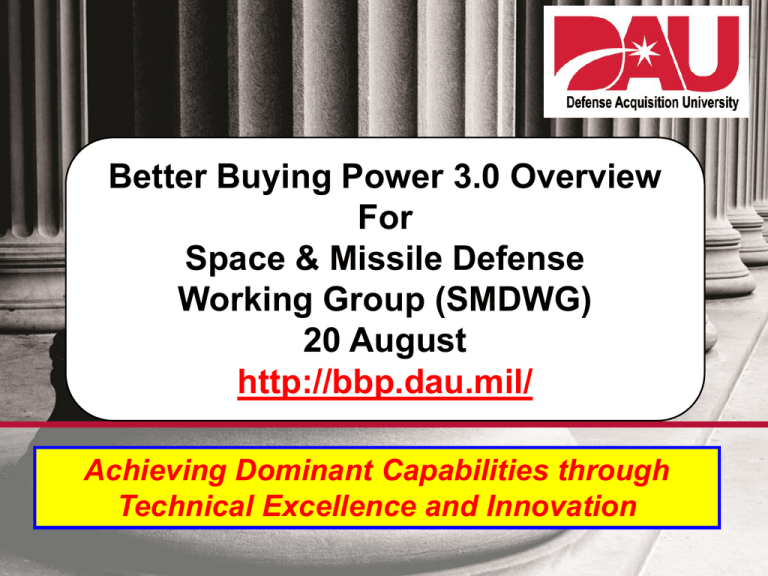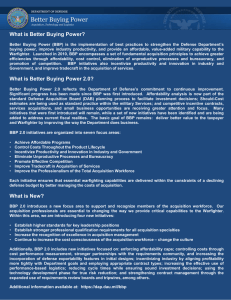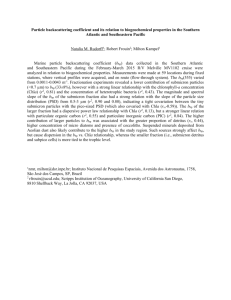Better Buying Power 3.0 Brief
advertisement

Better Buying Power 3.0 Overview For Space & Missile Defense Working Group (SMDWG) 20 August http://bbp.dau.mil/ Achieving Dominant Capabilities through Technical Excellence and Innovation 0 Better Buying Power Overview • USD(AT&L) launched BBP in 2010 to restore affordability and productivity to Defense spending • BBP 1.0 Directs us to utilize Best Practices • BBP 2.0 Moves us to Critical Thinking and a culture of cost consciousness • BBP 3.0 Emphasizes Better Products through innovation and technical superiority 1 Better Buying Power 3.0 • Better Buying Power reflects the Department of Defense’s commitment to continuous improvement – making productivity and cost consciousness part of our culture • BBP 3.0 expands the focus to technical excellence and innovation. It builds on the previous BBP releases and includes all focus areas from BBP 2.0. The 3.0 release encompasses 34 initiatives organized into eight focus areas – – – – – – – – Achieve Affordable Programs Achieve Dominant Capabilities While Controlling Lifecycle Costs Incentivize Productivity in Industry and Government Incentivize Innovation in Industry and Government Eliminate Unproductive Processes and Bureaucracy Promote Effective Competition Improve Tradecraft in Acquisition of Services Improve the Professionalism of the Total Acquisition Workforce 2 Better Buying Power 3.0 Focus Areas • Achieve Affordable Programs • Control Costs Throughout the Product Lifecycle • Incentivize Productivity in Industry and Government • Incentivize Innovation in Industry and Government • Eliminate Unproductive Processes and Bureaucracy • Promote Effective Competition • Improve Tradecraft in Acquisition of Services • Improve the Professionalism of the Total Acquisition Workforce 3 Better Buying Power 3.0 Achieving Dominant Capabilities through Technical Excellence and Innovation Achieve Affordable Programs • Continue to set and enforce affordability caps Achieve Dominant Capabilities While Controlling Lifecycle Costs • Strengthen and expand “should cost” based cost management • Anticipate and plan for responsive and emerging threats by building stronger partnerships of acquisition, requirements, and intelligence communities • Institutionalize stronger DoD level Long Range R&D Program Plans • Strengthen cybersecurity throughout the product lifecycle Incentivize Productivity in Industry and Government • Align profitability more tightly with Department goals • Employ appropriate contract types, but increase the use of incentive type contracts • Expand the superior supplier incentive program • Ensure effective use of Performance-Based Logistics • Remove barriers to commercial technology utilization • Improve the return on investment in DoD laboratories • Increase the productivity of corporate IRAD Incentivize Innovation in Industry and Government • Increase the use of prototyping and experimentation • Emphasize technology insertion and refresh in program planning • Use Modular Open Systems Architecture to stimulate innovation • Increase the return on and access to small business research and development • Provide draft technical requirements to industry early and involve industry in funded concept definition • Provide clear and objective “best value” definitions to industry Eliminate Unproductive Processes and Bureaucracy • Emphasize acquisition chain of command responsibility, authority, and accountability • Reduce cycle times while ensuring sound investments • Streamline documentation requirements and staff reviews • Remove unproductive requirements imposed on industry Promote Effective Competition • Create and maintain competitive environments • Improve DoD outreach for technology and products from global markets • Increase small business participation, including through more effective use of market research Improve Tradecraft in Acquisition of Services • Strengthen contract management outside the normal acquisition chain – installations, etc. • Improve requirements definition for services • Improve the effectiveness and productivity of contracted engineering and technical services Improve the Professionalism of the Total Acquisition Workforce • Establish higher standards for key leadership positions • Establish stronger professional qualification requirements for all acquisition specialties • Strengthen organic engineering capabilities • Ensure development program leadership is technically qualified to manage R&D activities • Improve our leaders’ ability to understand and mitigate technical risk • Increase DoD support for STEM education Continue Strengthening Our Culture of: Cost Consciousness, Professionalism, and Technical Excellence Ideas retained from BBP 2.0 and/or BBP 1.0 New in BBP 3.0 4 Better Buying Power 3.0 . Achieving Dominant Capabilities through Technical Excellence and Innovation Achieve Affordable Programs • Continue to set and enforce affordability caps Achieve Dominant Capabilities While Controlling Lifecycle Costs • Strengthen and expand “should cost” based cost management • Anticipate and plan for responsive and emerging threats by building stronger partnerships acquisition, requirements, and intelligence communities (We must be aware and responsive to changes in the threat. The acquisition, intelligence, and requirements communities must work together to ensure threat information is identified and provided throughout the lifecycle.) • Institutionalize stronger DoD level Long Range R&D Program Plans (Study and prioritize various technologies to provide enduring advantage to US forces.) • Strengthen cybersecurity throughout the product lifecycle (All our efforts to improve technological superiority will be in vain if we do not provide effective cybersecurity throughout the product lifecycle.) 5 Affordability and Should Cost A Materiel Solution Analysis B C Technology Engineering and Maturation & Manufacturing Development Risk Reduction Emphasis on Affordability (scope reduction) Production & Deployment Operations & Support Emphasis on Should Cost (efficiencies) • Affordability consists of setting cost targets consistent with resource constraints – program scope may be altered • Should-cost* targets are based on efficiencies – not scope changes – and generally refer to the way work is performed (e.g. common parts buys, process changes, accelerated orders) • Should Cost Management involves continuous scrutiny of all cost elements, such as challenging assumptions, dissecting overhead and indirect costs, and appropriate cost incentives *BBP Should Cost is not the pre-contract Should Cost described in FAR 15.407-4 & DFARS 215-407-4 6 Better Buying Power 3.0 . Achieving Dominant Capabilities through Technical Excellence and Innovation Incentivize Productivity in Industry and Government • Align profitability more tightly with Department goals • Employ appropriate contract types, but increase the use of incentive type contracts (CPIF and FPIF contracts are highly correlated with better cost and schedule performance.) • Expand the superior supplier incentive program (We will not implement a DoD-level SSIP, but rather will implement Service-specific SSIPs.) • Ensure effective use of Performance-Based Logistics • Remove barriers to commercial technology utilization (Understand the barriers that exist and find ways to reduce or remove them.) • Improve the return on investment in DoD laboratories the ROI of these facilities.) (We must increase • Increase the productivity of corporate IRAD (>$4B annually; This initiative will improve communication between DoD and industry and restore a higher degree of government oversight of this investment.) 7 Employ Appropriate Contract Types Risk Considerations Cost Reimbursement Greater Risk to the Contractor Fixed Price Greater Risk to the Government Factors to Consider in Selecting Contract Type • • • • • • Adequacy of the contractor’s accounting system • Concurrent contracts • Extent and future of subcontracting opportunities • Acquisition history Price Competition Complexity of the requirement Urgency of the requirement Period of Performance (e.g. Prod Qty) Technology Maturity Align with Technology & Mfg Technical requirements, labor, Vague technical requirements; Maturity material, and production capability labor and material costs uncertain stable; fair & reasonable prices determinable CPAF* CPFF CPIF FPI (F) FPAF FFP (not all inclusive) * - Use of CPAF requires extreme justification, to include lack of any objective criteria for incentive 8 Better Buying Power 3.0 . Achieving Dominant Capabilities through Technical Excellence and Innovation Incentivize Innovation in Industry and Government • Increase the use of prototyping and experimentation • Emphasize technology insertion and refresh in program planning (Design our acquisition programs plans to support technology refresh cycles on a more frequent time scale.) • Use Modular Open Systems Architecture to stimulate innovation • Increase the return on and access to small business research and development (Ensure DoD makes it as easy as possible for small businesses to work with DoD.) • Provide draft technical requirements to industry early and involve industry in funded concept definition (DoD needs to communicate with industry as much as possible up until the final RFP is released.) • Provide clear and objective “best value” definitions to industry (Provide industry with info on the monetary value of performance that exceeds the minimally acceptable or threshold levels.) 9 Better Buying Power 3.0 . Achieving Dominant Capabilities through Technical Excellence and Innovation Eliminate Unproductive Processes and Bureaucracy • Emphasize acquisition chain of command responsibility, authority, and accountability • Reduce cycle times while ensuring sound investments (New DoDI 5000.02 allows a high degree of tailoring to accept risk and reduce “time to market.” In addition, some of the successful rapid acquisition initiatives used to support ops in Iraq & Afghanistan will be integrated into our standard practices.) • Streamline documentation requirements and staff reviews (Excessive management time is spent It’s the Latest Government Guidance on supporting staff reviews instead of focusing on ‘Managing Paperwork for Small program execution.) Businesses’ • Remove unproductive requirements imposed on industry (We will establish a single threshold for both Earned Value Mgt compliance reviews and ongoing system surveillance at $100M.) 10 Better Buying Power 3.0 . Achieving Dominant Capabilities through Technical Excellence and Innovation Promote Effective Competition • Create and maintain competitive environments • Improve DoD outreach for technology and products from global markets (…investments in cooperative research, co-development, and co-production may also provide better products for our warfighters at reduced cost.) • Increase small business participation, including through more effective use of market research Improve Tradecraft in Acquisition of Services • Strengthen contract management outside the normal acquisition chain – installations, etc. • Improve requirements definition for services • Improve the effectiveness and productivity of contracted engineering and technical services (Enterprise approaches for acquiring these engineering and technical services should be used to increase effectiveness, improve technical information management, and promote innovation and maintain technical superiority.) 11 Better Buying Power 3.0 . Achieving Dominant Capabilities through Technical Excellence and Innovation Improve the Professionalism of the Total Acquisition Workforce • Establish higher standards for key leadership positions (continuing effort) • Establish stronger professional qualification requirements for all acquisition specialties • Strengthen organic engineering capabilities (We can’ t make decisions about technology if we don’t fully understand what is possible and how to achieve it.) • Ensure development program leadership is technically qualified to manage R&D activities (The Department must ensure that technically qualified leaders are available and assigned to managing our development programs.) • Improve our leaders’ ability to understand and mitigate technical risk • Increase DoD support for STEM education (This initiative focuses on developing the next generation of STEM professionals.) 12 Summary • BBP 3.0 – More continuity than change, but there is a new emphasis on our products and their ability to provide military technological superiority • Requires innovative and thoughtful planning and execution – Encourages the acquirer to creatively adapt to the specific circumstances of their program • The theme that ties the content of BBP 3.0 together is an overriding concern that our technological superiority is at risk • Our ability to utilize sources of innovation and technology effectively rests on the professionalism of our workforce Achieving Dominant Capabilities through Technical Excellence and Innovation 13






